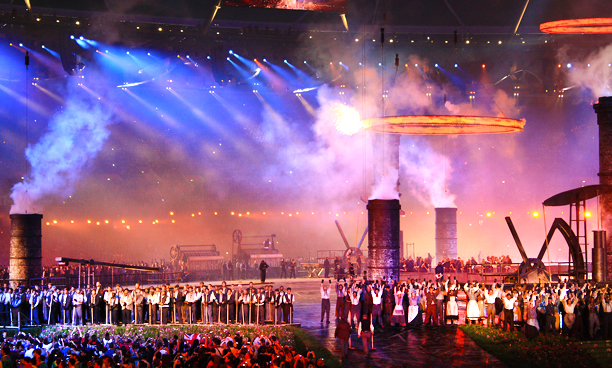
The London 2012 Olympics Opening and Closing Ceremonies wowed their audience – but presented their sound and lighting designers with enormous technical challenges.
Artistic directors Danny Boyle and Kim Gavin gave the games their most creative celebrations to date, but it was Australian company Norwest Productions and UK partner Delta Sound who had to devise a suitable to provide fibre-optic signal transport, custom RF solutions, LAN networking and audio playout. Their sophisticated connectivity made the sound design of fellow Australian Scott Willsallen (of Auditoria) possible.
Norwest Project Manager, Andy Marsh, knew that the network system required for a new 80,000-capacity Olympic Stadium would present real challenges: ‘We needed to overcome difficult cable runs,’ he says. ‘The cable installation took us in excess of three weeks and was more akin to installing cable permanently into a venue. On top of this, the inclusion of many fully live musical acts – adding further size and complexity to the main Optocore fibre system and backup systems – placed a considerable load on all the experienced audio engineers involved.’
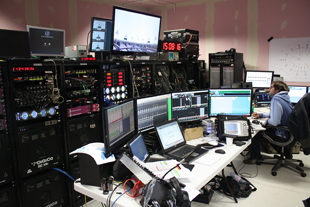 Optocore has long been at the heart of Norwest’s main digital systems – and more than 50 devices were used from an inventory shared with Delta Sound.
Optocore has long been at the heart of Norwest’s main digital systems – and more than 50 devices were used from an inventory shared with Delta Sound.
Since the specification called for all Optocore R-series devices, Norwest purchased a number of the new energy-efficient converters to accommodate the design’s high channel and node count. Additional DD4MR-FX, DD32R-FX, X6R-FX-8AE/8MI, X6R-TP-8AE/8MI and X6P-16IN devices – with their increased features and efficiency, reduced carbon footprint, power consumption (of 40%) and cost – joined a quantity of DD4MR-FX, DD2FR-FX and X6R-FX units purchased by Delta Sound for the event.
‘Optocore is unique in its ability to matrix a high channel count over large distances, plus providing the redundancy of a ring network,’ Marsh says. ‘Most significantly, it is extraordinarily robust and reliable, which is essential to a show that is playing to 80,000 people live in the arena and four billion watching on TV.’
The integration necessary to meet Auditoria’s detailed and dual-redundant design involved deploying multiple Optocore fibre networks, with full analogue back-up, principally for the main PA and Broadcast systems.
The main 24-node ring collected and distributed all inputs and outputs on a 2Gbit network to a myriad of broadcast and PA locations, and Optocore also delivered both PA and monitor feeds, plus timecode and programme. In total there were 696 I/O channel feeds within the Optocore topography.
This was one of the first uses of the German company’s new 2.21 protocol, which enabled 2Gbit bandwidth operation – and was crucial to meet the main requirement of a high channel count. Another unique feature of the set-up was that Norwest were using all 24 IDs – taking advantage of the maximum capacity of the fibre ring. They also used a quantity of Optocore’s TP devices, which provided a Cat5 extension of the ring.
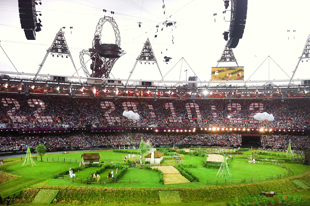 With multi-mode distances of up to 350m between nodes, and single-mode distances running anything up to 1km between nodes, the scale of the complete fibre network was in excess of 5km (with Dolby Lake processors providing the main system switchover between networks).
With multi-mode distances of up to 350m between nodes, and single-mode distances running anything up to 1km between nodes, the scale of the complete fibre network was in excess of 5km (with Dolby Lake processors providing the main system switchover between networks).
The broadcast ring, meanwhile, tied the main system to the Delta Media truck for all necessary I/O. Delta Media delivered downstream mixes of playback, live and atmos mics to both CTV and OBS for their broadcast of the ceremony.
In the transmission path, all signals were converted to digital on entering the Optocore environment, while the back-up system ran analogue from a DiGiCo SD7’s SD rack outputs. The feeds were delivered via AES to a massive FOH PA comprising entirely L-Acoustics components, with 220 VDosc, 100 Kudo, 55 Arcs, 88 SB28 subs and some 12XT fills – all driven from LA8 amplifiers.
Marsh credits his own crew, and in particular Justin Arthur (Optocore and Patch Engineer), as well as the Delta Sound crew, led by overall project manager Steve Lutley, plus Senior Systems Engineer from Autograph, Rob Tory. ‘We all worked seamlessly together to make this a huge success, and the relationship between us could not have been better,’ he says.
Audio playout and sync
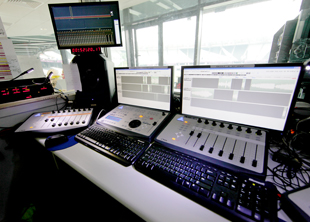 Since Athens in 2004, Merging Technologies’ Pyramix DAW has been the source of the pre-recorded audio for the closing show and the time code output that drives the broadcast and event timing.
Since Athens in 2004, Merging Technologies’ Pyramix DAW has been the source of the pre-recorded audio for the closing show and the time code output that drives the broadcast and event timing.
The complexity of the event required the Pyramix system to be expanded and upgraded for the 2012 event, in order to allow 128 channels of audio to be played back. The job of specifying what was needed fell to Auditoria’s Scott Willsallen, who had responsibility for the total audio installation in the stadium.
The output from the Pyramix was fed via two Madi streams into the DiGiCo SD7 console, and timcode was fed to the lighting, video playback, broadcast and pyrotechnics, as well as being used by the stage managers and directors to cue talent and live events.
The man with his finger on the trigger was Trevor Beck, who has been in a similar position several times before: ‘Pyramix has repeatedly proven to be rock-solid,’ he reports. ‘I have to have confidence that everything will work every single time I hit the play button.
‘Pyramix has some very unique features over other programs that enable me to be incredibly flexible with shows live, and with billions watching these events, you have to get it right no matter what happens on the field, you can’t be limited by the software.’
The original choice of Pyramix was made before the Athens Olympics, moving away from less reliable audio machines. Choice was relatively limited at the time and some of the options were out of reach financially so Pyramix seemed to be a good choice. ‘One feature that is tremendously useful for these shows is the ability with Pyramix to drop seamlessly in and out of loops,’ says Adrian Riddell, Norwest General Manager. ‘If something takes a little longer than expected, we can programme in holding loops for the scene which can be activated at will. When it is time to move on, we can drop out of the loop and the time code continues.
‘It is hard to imagine life without this now.’
Axient pics up the mic baton...
On the microphone front, Norwest favoured Shure from early on in the systems design, and the games this summer marked Axient’s debut at an Olympic Ceremony.
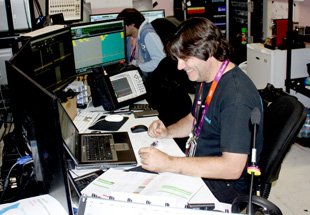 Norwest’s Chief RF specialist Steve Caldwell heard about the new product line from connections at Shure’s engineering team in the US, early in the product development process. Shortly after, the Axient systems were written into the final draft of the London plan by Scott Willsallen – who had to ensure that the Axient systems (which only became commercially available during the spring) would survive the intense media focus of the games.
Norwest’s Chief RF specialist Steve Caldwell heard about the new product line from connections at Shure’s engineering team in the US, early in the product development process. Shortly after, the Axient systems were written into the final draft of the London plan by Scott Willsallen – who had to ensure that the Axient systems (which only became commercially available during the spring) would survive the intense media focus of the games.
‘I wasn’t going to take any chances,’ he explains. ‘You don’t get a second chance at an event like this one. I really hammered Steve hard at the end of last year and in the spring of this year about whether Axient would be ready to do the job.’
Alongside audio quality, Caldwell’s case for Axient centred on several features of the new systems, including Frequency Diversity and the rechargeable battery technology developed for Axient (also used in Shure’s ULX-D digital wireless systems and PSM900/1000). ‘We used Shure KSM9s as the default standard mics on these systems, swapping to Beta 58s if the artists involved were a little bit more… shall we say… noisy. An Axient transmitter with a KSM9 sounds like you’re using a wired KSM9 – it just sounds great. That’s how it should be, of course, but it’s quite a step,’ Willsallen says.
‘With the Axient handhelds, we can transmit on two frequencies at the same time, should we need to,’ Caldwell explains. ‘We receive on two or maybe three receiver locations for each performer, for redundancy purposes. That has added so much confidence to the business of using handheld wireless mics.
‘The technology that’s gone into the rechargeables is also amazing,’ he continues. ‘At any time, I can see over the network down to five-minute increments how much battery life is left in each of those transmitters; I’ve never been able to do that before. And the time readout on the rechargeable is so reliable. That saves money and time; we’re not constantly throwing away AA batteries that are only half-used.’
‘It’s sustainable too,’ adds Willsallen. ‘This was flagged as the most sustainable Olympics yet, and to have something rechargeable that was that good was amazing. We would have used around 26,000 AA batteries otherwise, and they would have been no use to anybody afterwards, and gone straight into landfill.’
Axient’s efficient use of the available RF spectrum was also a key factor – Axient can operate over 20 wireless channels in a standard UK 8MHz TV channel. ‘The greater frequency efficiency of Axient was a big help,’ Caldwell says. ‘The spectrum plan was done to be used with UHF-R wireless mics; inserting the Axient was like an added bonus, because you can fit so many more channels into the same spectrum.’
Despite Willsallen’s initial caution, the Axient systems passed their baptism of fire. ‘I have to be quite uncompromising about these things,’ he says. ‘If there had been the slightest hint of problems with the Axient systems, I would have swapped back to using UHF-R systems. But there wasn’t a hitch.’
Caldwell’s Shure contacts include key members of the US Axient engineering and design team, but all on-site support for the gameswas handled by Shure Distribution UK (SDUK). ‘The Olympic Games on your doorstep is a once-in-a-lifetime opportunity’ says SDUK Applications & Product Manager, Tuomo Tolonen. ‘Everyone involved with the production put on four amazing memorable shows and I am pleased we’ve been able to be a part of it and see Axient deliver on the largest show imaginable.’
More: www.optocore.com
More: www.merging.com
More: www.l-acoustics.com
More: www.digico.org
More: www.axient.net